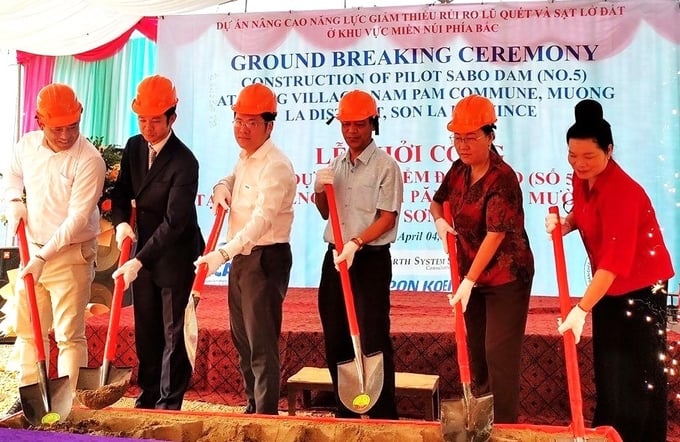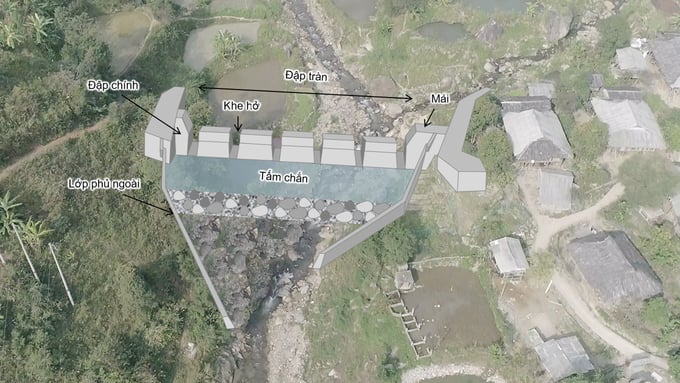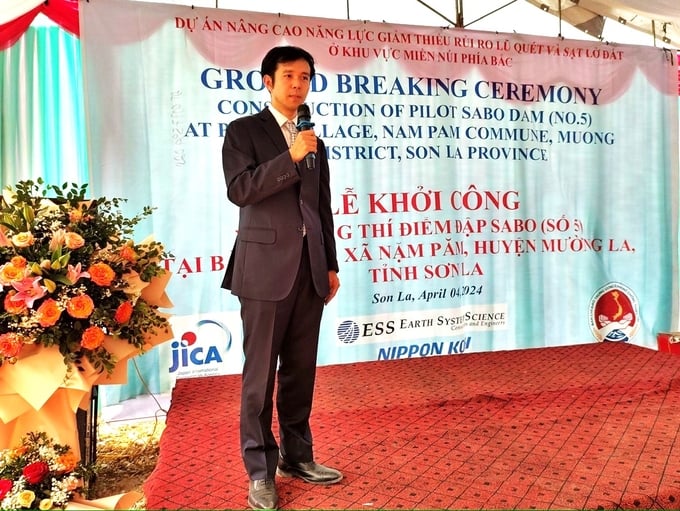November 24, 2025 | 17:17 GMT +7
November 24, 2025 | 17:17 GMT +7
Hotline: 0913.378.918
November 24, 2025 | 17:17 GMT +7
Hotline: 0913.378.918

Delegates performing the groundbreaking ceremony for the construction of the experimental Sabo dam. Photo: Le Quynh.
The Vietnam Disaster and Dyke Management Authority under the Ministry of Agriculture and Rural Development, in collaboration with Son La province's Department of Agriculture and Rural Development and the Japan International Cooperation Agency (JICA) Vietnam Office, held a groundbreaking ceremony for the construction of the first experimental Sabo dam in Vietnam at Pieng village, Nam Pam commune, Muong La district. The ceremony was held on the morning of April 4 in Son La province.
The Sabo dam is one of the most effective engineering solutions to mitigating the impacts of erosion and flash floods. These dams are typically constructed on the upper reaches of rivers with steep slopes and high flow velocities. Additionally, Sabo dams help retain sediment, floating debris, and prevent damage in downstream areas.

Simulation of the experimental Sabo dam in Muong La district, Son La province.
The construction of the experimental Sabo dam is one of the most important activities within the framework of the Technical Cooperation Project for Strengthening the capacity to cope with and minimize damages caused by flash floods and landslides for the northern mountainous region of Vietnam. The project has been implemented across 14 northern mountainous provinces of Vietnam since 2022 through a partnership between the Vietnam Disaster and Dyke Management Authority and JICA.
The construction of the experimental Sabo dam in Son La province is expected to serve as a reference for the Government of Vietnam to establish technical standards for Sabo dam design, before initiating the construction of other Sabo dams in high-risk areas. Furthermore, the contruction of this dam will reinforce the National Planning for Disaster Prevention and Water Resources from 2021 to 2030, with a vision towards 2050.

Mr. Suzuki Takashi, Advisor on Disaster Risk Management at the Ministry of Agriculture and Rural Development, delivering remarks at the ceremony. Photo: Le Quynh.
Flash floods and landslides caused by heavy rainfall have occurred at an increased frequency within the last few years. Consequently, they resulted in severe damages in the northern mountainous region of Vietnam.
In Muong La district, flash floods and landslides in August 2017 resulted in 15 fatalities and disappearances, 15 injuries, and up to 705 billion Vietnamese dong in total economic losses. Continuous heavy rains in early August 2023 also led to flash floods and landslides within the district, causing damage to 134 local residences.
Additionally, JICA plans to actively collaborate with the Government and people of Japan to support Vietnam in disaster risk management in the immediate future.
Translated by Nguyen Hai Long
/2025/11/22/4018-4-213342_747.jpg)
(VAN) The Mekong Delta Agricultural Experts Club has attracted 143 experts and researchers to participate in providing consultancy and contributing initiatives to the development of one million hectares of high-quality rice.

(VAN) Ca Mau’s development of OCOP products opens a path to increasing cooperatives value, helping boost income, expand markets, and affirm collective economy's role.

(VAN) Turning seemingly ordinary coconut shells into unique jewelry and artwork, Nguyen Bang Nhi spreads the value of local culture through her brand, Cocohand.

(VAN) Results from the Sustainable Durian Model Project in Dak Lak have confirmed the critical role of Yara Viet Nam in transferring advanced nutritional solutions to farmers.

(VAN) In Tuyen Quang province, livestock farmers have introduced effective models and innovative practices that significantly strengthen African Swine Fever prevention and control efforts.

(VAN) This is the study conducted by IRRI and Can Tho University on the rice straw value chain in Mekong Delta showing an economic potential of more than 6.6 trillion VND/year.

(VAN) By participating in cooperative economics, many farmers in Tay Ninh have overcome hardship, mastered clean dragon fruit cultivation techniques.